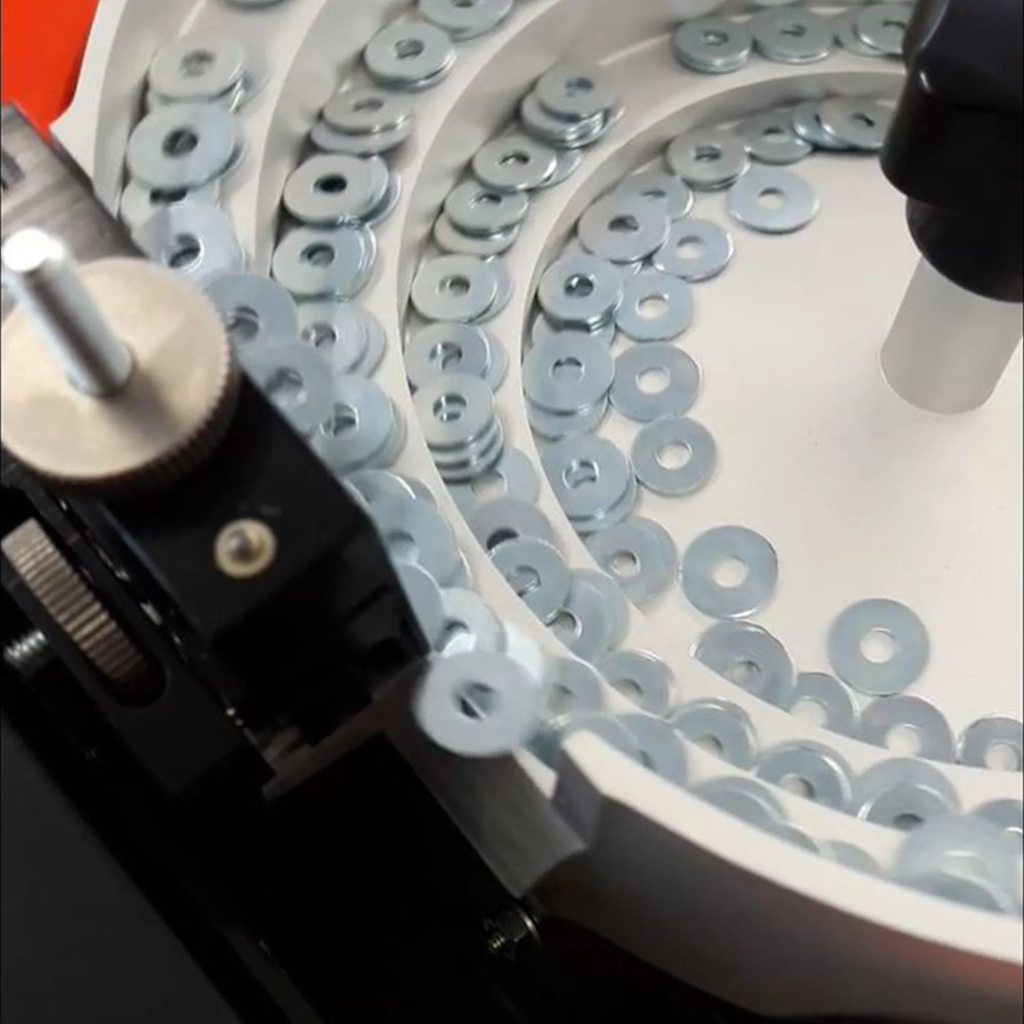
Maximizing Efficiency in Packaging with an Automatic Small Parts Counter
In the world of high-precision manufacturing and packaging, businesses face a common challenge: accurately counting and packaging small parts while maintaining speed and efficiency. Whether in the pharmaceutical, electronics, medical device, or hardware industries, companies rely on precise counting systems to avoid costly errors, ensure product consistency, and meet strict regulatory requirements. An automatic small…

Table of Contents
In the world of high-precision manufacturing and packaging, businesses face a common challenge: accurately counting and packaging small parts while maintaining speed and efficiency. Whether in the pharmaceutical, electronics, medical device, or hardware industries, companies rely on precise counting systems to avoid costly errors, ensure product consistency, and meet strict regulatory requirements.
An automatic small parts counter for packaging is a game-changer for companies looking to streamline operations, reduce human error, and improve productivity. These machines offer fast, reliable, and highly accurate counting solutions, making them essential for businesses dealing with tiny components, fasteners, tablets, and other small items.
In this article, we will explore the importance of accurate small-part counting, the advantages of automatic counting systems, how they work, and what to consider when choosing the right machine for your business.
Why Accurate Small Parts Counting is Crucial for Packagin
When packaging small parts, accuracy is everything. Even the smallest miscalculation can lead to product inconsistencies, customer complaints, and financial losses. Here’s why precision counting is essential:
1. Preventing Product Shortages or Overages
A manual miscount—whether it results in too few or too many parts per package—can create major problems. Shortages lead to customer dissatisfaction and returns, while overages cause unnecessary costs and wasted materials.
2. Ensuring Compliance with Industry Standards
Many industries, such as pharmaceuticals and medical devices, have strict regulatory guidelines that require exact product counts. Failing to meet these standards can lead to legal issues, product recalls, and lost contracts.
3. Improving Production Speed and Efficiency
Manual counting is slow and error-prone. Employees can become fatigued, leading to mistakes. An automatic small parts counter for packaging speeds up the process, ensuring consistent accuracy while reducing labor costs.
4. Enhancing Brand Reputation
Consistently delivering correct product quantities builds trust with customers. Automated counting helps businesses maintain quality control, reinforcing brand reliability and credibility.
How an Automatic Small Parts Counter for Packaging Works
An automatic small parts counter is designed to precisely count and dispense small items at high speeds. These machines use advanced sensors, software, and mechanical components to ensure every package contains the correct quantity.
Key Components of an Automatic Small Parts Counter
- Feeding System: Ensures parts move into the counting area in a controlled manner.
- Optical or Sensor-Based Counting: High-resolution sensors or cameras detect and count each item as it moves along a conveyor or vibratory feeder.
- Sorting & Dispensing Mechanism: Directs the correct number of parts into the packaging area.
- User Interface & Controls: Allows operators to set counting parameters, batch sizes, and error detection features.
Types of Automatic Small Parts Counters
There are several types of automated counters, each suited for different applications:
- Vibratory Bowl Counters – Ideal for counting irregularly shaped components such as screws, bolts, and fasteners.
- Optical Counting Machines – Best for pharmaceutical tablets, microchips, and small uniform parts.
- Weight-Based Counting Machines – Uses highly accurate weight calculations to determine the number of items in a batch.
Each system is designed to handle specific part sizes, shapes, and material types, making it essential to choose the right counter for your packaging needs.
Advantages of Using an Automatic Small Parts Counter for Packaging
Investing in automated counting technology brings a wide range of benefits, from improving efficiency to reducing costs.
1. Unmatched Accuracy & Consistency
Modern automatic counters use high-precision sensors and AI-driven algorithms to eliminate human error. This ensures consistent and accurate product counts, minimizing losses due to miscounting.
2. Faster Production Speeds
Compared to manual counting, automated machines increase output dramatically. A task that might take hours manually can be completed in minutes using an automatic small parts counter.
3. Reduced Labor Costs
By automating the counting process, businesses can reallocate employees to more critical tasks, reducing reliance on manual labor and cutting overall operational costs.
4. Better Quality Control
Many counting machines integrate real-time quality checks. If a batch contains an incorrect number of parts, the system can flag and reject it, preventing defective packages from reaching customers.
5. Versatility for Different Industries
Automatic small parts counters are widely used in:
- Pharmaceuticals – Counting tablets, capsules, and pills for precise dosage packaging.
- Electronics – Ensuring correct quantities of microchips, resistors, and circuit components.
- Hardware & Fasteners – Counting nails, screws, and bolts for toolkits.
- Medical Devices – Packing syringes, needles, and surgical components.
6. Integration with Packaging Lines
Most modern counting machines can be seamlessly integrated into automated packaging lines, ensuring smooth product flow from counting to sealing and labeling.
Choosing the Right Automatic Small Parts Counter for Your Business
When selecting an automatic small parts counter for packaging, businesses should consider several factors:
Choosing the Right Automatic Small Parts Counter for Your Business
Selecting the best automatic small parts counter for packaging requires careful consideration of several key factors. Since different industries and applications have unique requirements, businesses should assess their specific needs before investing in a counting machine. Below, we expand on the six most important aspects to evaluate when choosing a precision counting system for packaging operations.
1. Type and Size of Parts
One of the most critical factors in selecting an automatic small parts counter is ensuring that the machine can handle the specific size, shape, and material composition of the items being counted.
For example:
- Pharmaceutical companies require tablet and capsule counters that are designed to handle small, lightweight, and fragile pills without crushing them.
- Hardware and fastener manufacturers need robust counters that can accurately process metal screws, bolts, nuts, and washers, ensuring that parts do not jam or cause damage to the machine.
- Electronics companies packaging microchips, resistors, or connectors require highly sensitive counters that detect even the smallest variations in size and weight.
Additionally, some counters are designed specifically for uniform parts, while others have advanced detection systems to count irregularly shaped items. Choosing a counter that matches your product specifications ensures smooth operation and reduces the risk of miscounts or machine malfunctions.
2. Counting Speed Requirements
Speed is another crucial consideration, especially for businesses that operate in high-volume production environments. The faster a machine can count and package small parts, the more efficient the workflow and the lower the labor costs.
- Low-speed counters (100–500 parts per minute) are suitable for small-scale operations where precision is more critical than speed.
- Mid-range counters (500–5,000 parts per minute) are ideal for medium-sized manufacturers balancing speed and accuracy.
- High-speed counters (5,000+ parts per minute) are essential for large-scale industries requiring maximum throughput.
High-speed machines must also maintain counting accuracy to prevent losses caused by mispackaging, overfills, or shortages. Investing in a counter with adjustable speed settings ensures flexibility for different production demands.
3. Integration with Existing Equipment
For companies with established automated packaging lines, it is essential to choose a small parts counter that seamlessly integrates with existing machinery. This includes compatibility with:
- Conveyor belts that transport counted items into sealing or labeling machines.
- Weighing systems that verify the correct quantity before final packaging.
- Bagging or bottling machines that automatically package counted products.
Without proper integration, companies may face delays, production bottlenecks, or manual intervention requirements, which can reduce efficiency and increase operating costs. Choosing a counter that supports modular automation allows for easy upgrades as business needs evolve.
4. Error Detection Capabilities
Accuracy is a top priority in small parts packaging, and even minor miscounts can lead to:
- Customer complaints due to missing or excess products.
- Regulatory compliance issues, particularly in pharmaceuticals and medical devices.
- Financial losses from overpacking or needing to recall miscounted products.
To prevent these problems, many modern counters come equipped with advanced error detection technology, including:
- Optical sensors and cameras that scan for incorrect part quantities.
- Weight verification systems that compare the expected vs. actual package weight.
- AI-powered smart detection that can recognize variations in shape, size, and density.
Automated error detection and correction features help maintain quality control and reduce waste, ensuring that every package meets customer and industry standards.
5. User-Friendly Interface
Operating an automatic small parts counter for packaging should be simple, even for employees with minimal technical expertise. The best machines include:
- Touchscreen controls with intuitive navigation.
- Pre-programmable settings for different product types.
- Real-time monitoring and alerts for quick adjustments.
A user-friendly design ensures that employees can easily set up, adjust, and troubleshoot the machine, reducing training time and human errors. Some advanced models even offer remote access features, allowing supervisors to monitor operations from a smartphone or computer.
6. Cost and ROI Considerations
While purchasing an automatic small parts counter requires an initial investment, the long-term cost savings and efficiency improvements make it a valuable asset. Businesses should evaluate:
- Initial Purchase Cost – Prices vary based on counting speed, technology, and additional features.
- Operational Cost – Energy consumption, maintenance requirements, and potential labor savings.
- Return on Investment (ROI) – Faster production, fewer miscounts, and reduced labor needs lead to cost recovery over time.
For businesses processing thousands or millions of parts per month, an automated counter can pay for itself within months by improving accuracy, speed, and labor efficiency.
Why Miniature Folding is the Leading Provider of Small Parts Counting Solutions
At Miniature Folding, we understand the importance of accuracy and efficiency in small parts packaging. Our cutting-edge automatic small parts counters are designed for businesses looking to enhance productivity while maintaining strict quality control.
With years of expertise in precision packaging solutions, we help companies in pharmaceutical, electronics, medical, and industrial sectors streamline their operations with state-of-the-art counting technology.
Why Choose Miniature Folding?
✔ Advanced small parts counting technology with high accuracy.
✔ Customizable solutions tailored to your packaging needs.
✔ Seamless integration with existing production lines.
✔ Reliable support and maintenance to keep your operations running smoothly.
The Future of Small Parts Counting in Packaging
As businesses move toward automation and efficiency, the demand for automatic small parts counters for packaging continues to grow. These machines eliminate human error, increase productivity, and enhance product quality, making them an essential tool for industries that require precise counting and packaging of small items.
If you are looking to upgrade your packaging process and invest in a high-precision automatic small parts counter, Miniature Folding has the perfect solution for you.
Contact us today to learn more about our innovative counting technology and how it can transform your business.

Related Insights
Keep Exploring Sustainable Packaging Trends
 Read more
Read moreWhat Makes a Folding Insert High Quality? Key Features to Look For
High Quality Folding Inserts In the competitive landscape of packaging, folding inserts or folding sheets
 Read more
Read moreThe Ultimate Showdown: How Barcode Scanning Tags Stack Up Against QR Codes for Product Tracking
In the rapidly evolving landscape of inventory management and product tracking, businesses are increasingly relying
 Read more
Read moreEnhancing Patient Safety: How Folded Inserts Outperform Digital Information Leaflets
In the healthcare sector, effective communication is crucial, especially when it comes to patient safety.
